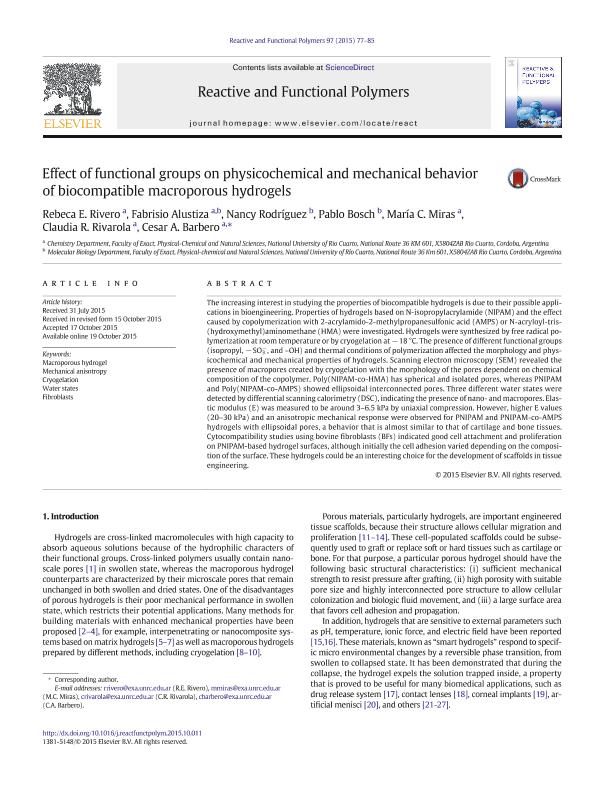Mostrar el registro sencillo del ítem
dc.contributor.author
Rivero, Rebeca Edith

dc.contributor.author
Alustiza, Fabrisio Eduardo

dc.contributor.author
Rodriguez, Nancy

dc.contributor.author
Bosch, Pablo

dc.contributor.author
Miras, Maria Cristina

dc.contributor.author
Rivarola, Claudia Rosana

dc.contributor.author
Barbero, César Alfredo

dc.date.available
2019-02-26T14:34:11Z
dc.date.issued
2015-12
dc.identifier.citation
Rivero, Rebeca Edith; Alustiza, Fabrisio Eduardo; Rodriguez, Nancy; Bosch, Pablo; Miras, Maria Cristina; et al.; Effect of functional groups on physicochemical and mechanical behavior of biocompatible macroporous hydrogels; Elsevier Science; Reactive & Functional Polymers; 97; 12-2015; 77-85
dc.identifier.issn
1381-5148
dc.identifier.uri
http://hdl.handle.net/11336/70839
dc.description.abstract
The increasing interest in studying the properties of biocompatible hydrogels is due to their possible applications in bioengineering. Properties of hydrogels based on N-isopropylacrylamide (NIPAM) and the effect caused by copolymerization with 2-acrylamido-2-methylpropanesulfonic acid (AMPS) or N-acryloyl-tris-(hydroxymethyl)aminomethane (HMA) were investigated. Hydrogels were synthesized by free radical polymerization at room temperature or by cryogelation at - 18°C. The presence of different functional groups (isopropyl, - SO3-, and -OH) and thermal conditions of polymerization affected the morphology and physicochemical and mechanical properties of hydrogels. Scanning electron microscopy (SEM) revealed the presence of macropores created by cryogelation with the morphology of the pores dependent on chemical composition of the copolymer. Poly(NIPAM-co-HMA) has spherical and isolated pores, whereas PNIPAM and Poly(NIPAM-co-AMPS) showed ellipsoidal interconnected pores. Three different water states were detected by differential scanning calorimetry (DSC), indicating the presence of nano- and macropores. Elastic modulus (E) was measured to be around 3-6.5 kPa by uniaxial compression. However, higher E values (20-30 kPa) and an anisotropic mechanical response were observed for PNIPAM and PNIPAM-co-AMPS hydrogels with ellipsoidal pores, a behavior that is almost similar to that of cartilage and bone tissues. Cytocompatibility studies using bovine fibroblasts (BFs) indicated good cell attachment and proliferation on PNIPAM-based hydrogel surfaces, although initially the cell adhesion varied depending on the composition of the surface. These hydrogels could be an interesting choice for the development of scaffolds in tissue engineering.
dc.format
application/pdf
dc.language.iso
eng
dc.publisher
Elsevier Science

dc.rights
info:eu-repo/semantics/openAccess
dc.rights.uri
https://creativecommons.org/licenses/by-nc-sa/2.5/ar/
dc.subject
Cryogelation
dc.subject
Fibroblasts
dc.subject
Macroporous Hydrogel
dc.subject
Mechanical Anisotropy
dc.subject
Water States
dc.subject.classification
Otras Ciencias Químicas

dc.subject.classification
Ciencias Químicas

dc.subject.classification
CIENCIAS NATURALES Y EXACTAS

dc.title
Effect of functional groups on physicochemical and mechanical behavior of biocompatible macroporous hydrogels
dc.type
info:eu-repo/semantics/article
dc.type
info:ar-repo/semantics/artículo
dc.type
info:eu-repo/semantics/publishedVersion
dc.date.updated
2019-02-22T18:13:55Z
dc.journal.volume
97
dc.journal.pagination
77-85
dc.journal.pais
Países Bajos

dc.journal.ciudad
Amsterdam
dc.description.fil
Fil: Rivero, Rebeca Edith. Consejo Nacional de Investigaciones Científicas y Técnicas. Centro Científico Tecnológico Conicet - Córdoba; Argentina. Universidad Nacional de Río Cuarto. Facultad de Ciencias Exactas Fisicoquímicas y Naturales. Departamento de Química; Argentina
dc.description.fil
Fil: Alustiza, Fabrisio Eduardo. Consejo Nacional de Investigaciones Científicas y Técnicas. Centro Científico Tecnológico Conicet - Córdoba; Argentina. Universidad Nacional de Río Cuarto. Facultad de Ciencias Exactas Fisicoquímicas y Naturales. Departamento de Química; Argentina. Universidad Nacional de Río Cuarto. Facultad de Ciencias Exactas Fisicoquímicas y Naturales. Departamento de Biología Molecular; Argentina
dc.description.fil
Fil: Rodriguez, Nancy. Universidad Nacional de Río Cuarto. Facultad de Ciencias Exactas Fisicoquímicas y Naturales. Departamento de Biología Molecular; Argentina
dc.description.fil
Fil: Bosch, Pablo. Consejo Nacional de Investigaciones Científicas y Técnicas. Centro Científico Tecnológico Conicet - Córdoba; Argentina. Universidad Nacional de Río Cuarto. Facultad de Ciencias Exactas Fisicoquímicas y Naturales. Departamento de Biología Molecular; Argentina
dc.description.fil
Fil: Miras, Maria Cristina. Universidad Nacional de Río Cuarto. Facultad de Ciencias Exactas Fisicoquímicas y Naturales. Departamento de Química; Argentina
dc.description.fil
Fil: Rivarola, Claudia Rosana. Consejo Nacional de Investigaciones Científicas y Técnicas. Centro Científico Tecnológico Conicet - Córdoba; Argentina. Universidad Nacional de Río Cuarto. Facultad de Ciencias Exactas Fisicoquímicas y Naturales. Departamento de Química; Argentina
dc.description.fil
Fil: Barbero, César Alfredo. Consejo Nacional de Investigaciones Científicas y Técnicas. Centro Científico Tecnológico Conicet - Córdoba; Argentina. Universidad Nacional de Río Cuarto. Facultad de Ciencias Exactas Fisicoquímicas y Naturales. Departamento de Química; Argentina
dc.journal.title
Reactive & Functional Polymers

dc.relation.alternativeid
info:eu-repo/semantics/altIdentifier/doi/https://doi.org/10.1016/j.reactfunctpolym.2015.10.011
dc.relation.alternativeid
info:eu-repo/semantics/altIdentifier/url/https://www.sciencedirect.com/science/article/pii/S1381514815300596
Archivos asociados
